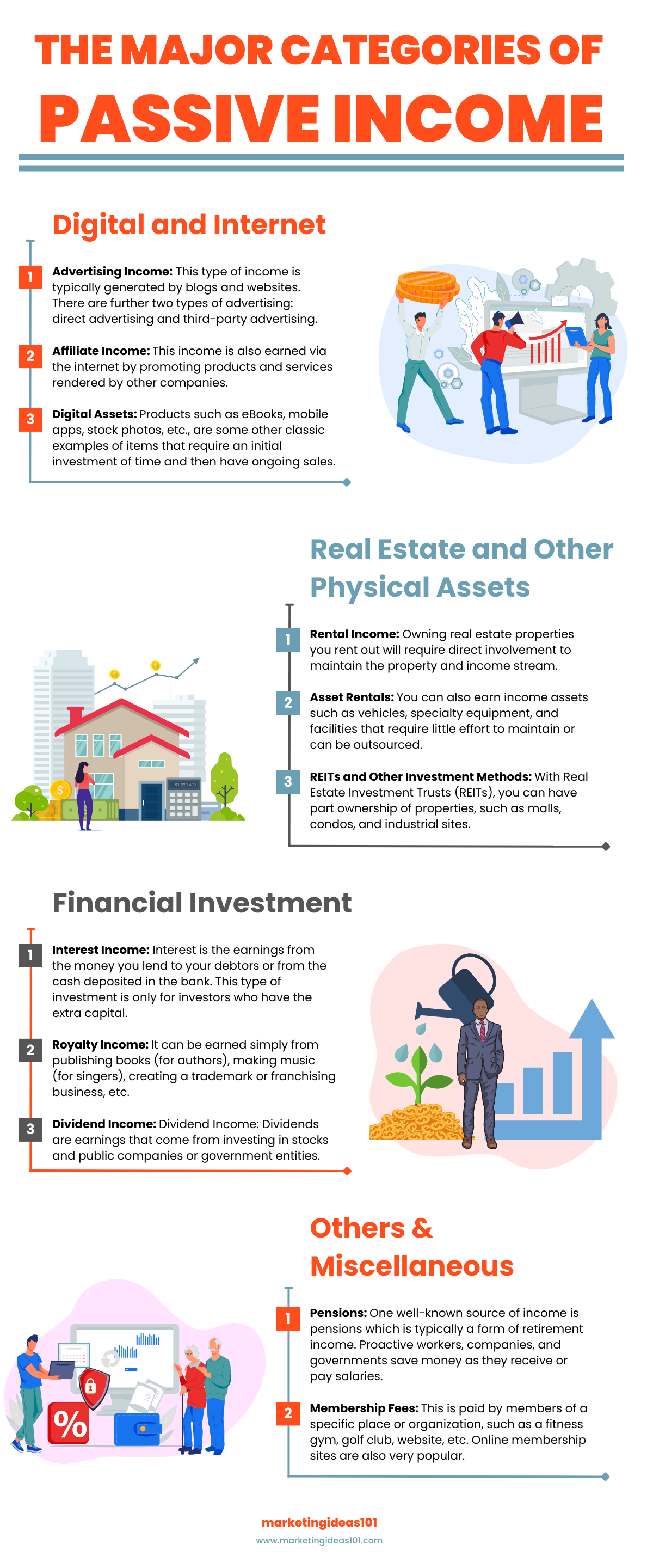Table of Contents
Earning money while sleeping might sound a bit exaggerated, but you can do that with a good plan in place. The good plan we are talking about here is called passive income. There is no fixed definition of passive income, but let’s make it easy for you. Passive income can be defined as a way to earn steady money with little to no daily effort.
Some passive income ideas, such as building a blog or a mobile app, take a lot of time and money to get up and alive. But they could help earn you money while you sleep. Your income is one of the best wealth-building tools, and no one can deny that. This tool typically requires you to work 9 to 5, five days a week. Even if you love your 9-5 job, we bet you wouldn’t mind earning some extra money without expending too much time or effort.
Wondering what passive income can do to you? Here is the answer:
- Increase your wealth
- Enable you to retire early
- Protect you from sitting idle without income in case you leave your job
- Provide an additional income source if your retirement funds get finished
But how can you generate money or assets without working on getting them? The question is a common one many businesses and entrepreneurial-minded individuals have asked for years. The idea of earning money or assets with little more to no effort is an attractive one. Any business person would want to generate income with the least effort, which differentiates a successful business from a struggling one.
Passive income is one of the IRS’s principal income categories; the others are active income and portfolio income. As with non-passive income, passive income is usually taxable (according to the Internal Revenue Service of the United States).
Another way to think about passive income is simply the income you incur by doing “very little or nothing” after the initial financial or time investment was made. Unlike active income, which requires you to participate and be fully involved for the stream of income to continue coming in, passive income involves an automated system or process that will continuously generate revenues without a high level of commitment.
For example, passive income earned from advertising revenue generated by a website or blog must first attract traffic and regular ongoing visitors. Before a site can gain that kind of traffic, the owner must first determine the niche, have the site and content developed, and have a marketing plan in place.
There are different levels, types, and ways of generating passive income. Some require significant upfront work and investment to get the income stream started. While others require various levels of ongoing effort to maintain and aren’t entirely hands-off. But the goal is always pretty much the same for anyone looking at passive income options – to have recurring income that allows your time to be allocated to other activities.
What will you learn in this eBook?
As the book’s name suggests, we will help you learn everything about passive income from scratch. After finishing this book, you will know in detail and how to create multiple passive income streams and be well on your way to true financial freedom.
Difference between Passive and Active Income
Unlike passive income, which can take several years to build, an active income ensures that you have a consistent income – for example, your salary. An active source of income is often essential to create a passive income stream and lay its foundation.
Active income and passive income are defined as follows:
Active Income: A stream of income received against the services one has performed. This income stream can include wages, salaries, commissions, tips, or any other income source.
Passive Income: Money that a person may get from their investment, rental property, mobile app, blog, or other sources in which they are not actively involved.
The Real Difference
Active income, while still being an investment, is a job. However, people don’t see it like that. For instance, flipping houses is a job. Wholesaling goods is a job. Even working in your shop and selling products/services is a job. It is essential to understand that anything that requires you to be actively involved in working doesn’t fall under a passive income stream category.
Deep pocket investors make money in their sleep without putting in any effort because they invest in passive income sources. Although these investors initially put in a lot of effort, they believe that finding the next big thing will provide them with more passive money.
If you like your active stream of income, continue with it. Especially if you are using money from that job to buy a passive investment, remember that you are working for your money for active income. On the contrary, if you have invested in a passive income source, the money will be working for you. However, starting a business or doing a job can fund those investments and lead towards financial freedom.
Active Income vs. Passive Income: Which One is better?
To be honest, passive income is much better than active income in several aspects. Just think about it – if you have a passive income stream that generates money for you without your active involvement, you can go on a vacation and come home to more money in your bank account.
Active income is the foundation for you to create a passive income stream, so don’t ignore it at all. Whether you want to make good money from your investments, rental property, blog, etc., you need to fund yourself first. Therefore, active income plays an essential role here as well.
Examples of Passive Income
- Profits earned from investments
- Affiliate income
- Display advertising
- Rental income
- Selling online courses
Examples of Active Income
- Salary
- Tips
- Hourly Wages
- Commissions
- Consulting and Freelance Services
Who Can Generate Passive Income?
In simple words, anyone with a good plan in place and some funds can generate a passive income for themselves. It doesn’t matter if you are employed, unemployed, a single mother, a part-time worker in an organization, a freelancer, or a prominent businessman; there are thousands of passive income investments you might want to check out.
If you are already doing a job and earning a decent income, you can put in some money from your salary or commission to invest in things that can make you money in your sleep. We will discuss many ideas and ways to create a passive income further in this eBook.
The Major Categories of Passive Income
There are numerous types of passive income sources with different strategies for success. In general, they can be classified into four major categories:
1. Digital and Internet
Digital products and services can provide a steady flow of passive income. They have the potential to create a revenue stream that can pay off for many years after the initial effort. Moreover, once you get the right system in place, your digital products can essentially sell on auto-pilot, creating a source of passive income. Examples are eBooks, mobile apps, affiliate sales, membership sites, etc. Two of the more common types of revenue streams include advertising and affiliate income.
Advertising Income: This type of income is typically generated by blogs and websites. There are further two types of advertising: direct advertising and third-party advertising. In third-party advertising, platforms such as Google AdSense and other PPC (Pay Per Click) advertising methods are utilized. A well-built website or mobile app asset can continue to bring in income as visitors visit the site.
Affiliate Income: This income is also earned via the internet by promoting products and services rendered by other companies. You earn a commission for every successful sale made of the product or service when your affiliate link is used to generate the sale. Email marketing, social media promotion, and other strategies that don’t require their own sites are also ways to earn income without a website or mobile app. One of the most popular programs is Amazon’s affiliate central.
Digital Assets: Products such as eBooks, mobile apps, stock photos, etc., are some other classic examples of items that require an initial investment of time and then have ongoing sales. There are many options to sell these products, such as Amazon, app stores, stock photography sites, eBook sites, and more.
2. Real Estate and Other Physical Assets
Real estate is one of the most popular ways of making passive income, and in reality, you don’t even have to directly own a brick-and-mortar property to be a real estate investor. Owning traditional brick-and-mortar properties is only a passive income source when all the right strategies are in place. The investment world has a wide range of methods for owning residential or commercial rental properties without requiring direct management.
Rental Income: Owning real estate properties you rent out will require direct involvement to maintain the property and income stream. However, you can outsource most of those tasks to property management companies, handyman services, etc.
Asset Rentals: You can also earn income assets such as vehicles, specialty equipment, and facilities that require little effort to maintain or can be outsourced.
REITs and Other Investment Methods: With Real Estate Investment Trusts (REITs), you can have part ownership of properties, such as malls, condos, and industrial sites. All of the management can be handled by others.
3. Financial Investment
Financial investments are the closest to genuinely providing a passive source of income of all the different types. Typically, they involve making an investment upfront with your money and taking a risk that the investment will yield positive returns. Once you make the investment, there is minimal maintenance required going forward. Examples are peer-to-peer lending, dividend stocks, annuities, certificate of deposits (CDs), etc.
Interest Income: Interest is the earnings from the money you lend to your debtors or from the cash deposited in the bank. This type of investment is only for investors who have the extra capital. Frugal savers can put their money in simple investments such as long-term CDs, fixed income bonds, or low-risk dividend stocks.
Royalty Income: It can be earned simply from publishing books (for authors), making music (for singers), creating a trademark or franchising business, etc. This income type usually requires a great talent, skill, or ability, and a great deal of work is put into creating these products upfront.
Dividend Income: Dividends are earnings that come from investing in stocks and public companies or government entities. The entities use your money to invest and profit from assets and services, which are shared with the investors. Some might not categorize it as a passive income since it usually involves higher risk and may not provide a regular income stream. It also requires proper management for the investment and the risk involved.
NOTE: Its always important to consider working with an investment professional for guidance on risks, tax implications, etc. when making financial investments.
4. Others & Miscellaneous
There are several other possible passive income sources, such as pension income, membership fees, licensing ideas, franchising, and many more.
Pensions: One well-known source of income is pensions which is typically a form of retirement income. Proactive workers, companies, and governments save money as they receive or pay salaries. Then at a certain point in time, the funds from the pension are allocated presumptively after having strong investment growth.
Membership Fees: This is paid by members of a specific place or organization, such as a fitness gym, golf club, website, etc. Online membership sites are also very popular. A lot of sites charge a low monthly fee for access. The content for these sites can include software, games, web applications, programming scripts, and videos.
Steps to Getting Started
Most types of passive income are built over time and aren’t earned instantly. Even direct investment income requires the initial investment to be earned. Getting started with a successful passive income plan will require patience, hard work, consistency, and the right strategy.
Passion is an essential factor in anything we do in life, and that’s no different when building a passive income strategy. Consider choosing what you love to do and find a passive income source closely related to those areas of interest. Your interests and knowledge can help energize and develop a successful strategy for building your passive income stream.
Another important component of building a successful passive income stream is to have an entrepreneurial spirit. If you can determine new marketplace needs, innovate a new way of doing something and generally be creative in your approach, you have a greater chance of success.
The idea of building sustainable wealth through passive income has an enormous appeal. Small business owners, retirees, students, office workers, stay-at-home parents, and really anyone can benefit from a sustainable passive income source that will continue to generate income. Finding the right opportunities and developing the right strategy will be the key to success.






